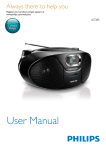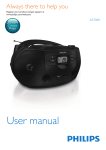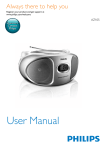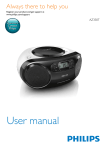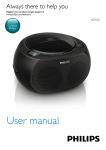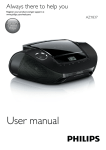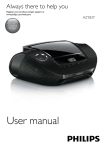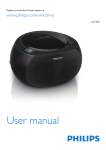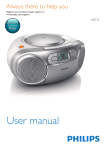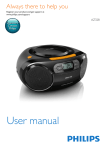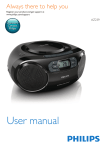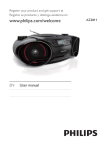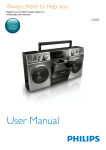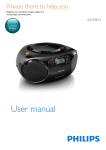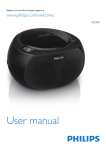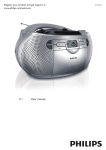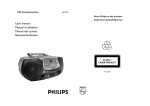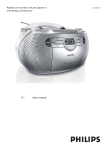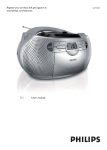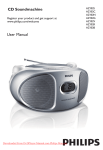Download Philips AZ1068
Transcript
Always there to help you Register your product and get support at www.philips.com/welcome Question? Contact Philips User manual AZ1068 English Contents 1Important2 Safety2 2Notice3 3 Your CD Soundmachine4 Introduction4 What’s in the box 4 Overview of the main unit 5 4 Get started7 Install batteries Connect AC power Turn on 7 8 8 5 Use your CD Soundmachine9 Play CD Play from USB Play from SD card Listen to radio Use your microphone Program tracks Control play 9 9 10 10 10 11 11 6 Product information12 Specifications Supported MP3 disc formats USB playability information 12 12 13 7Troubleshooting14 EN 1 1Important Safety • Make sure that there is enough free space around the product for ventilation. • Only use attachments or accessories specified by the manufacturer. • Battery usage CAUTION – To prevent battery leakage which may result in bodily injury, property damage, or damage to the product: • Install the batteries correctly, + and - as marked on the product. • Do not mix batteries (old and new or carbon and alkaline, etc.). • Remove the batteries when the product is not used for a long time. • The batteries shall not be exposed to excessive heat such as sunshine, fire or the like. • Use only power supplies listed in the user manual. • The product shall not be exposed to dripping or splashing. • Do not place any sources of danger on the product (e.g. liquid filled objects, lighted candles). • Where the mains plug or an appliance coupler is used as the disconnect device, the disconnect device shall remain readily operable. 2 EN Warning •• Never remove the casing of this device. •• Never lubricate any part of this device. •• Never place this device on other electrical equipment. •• Keep this device away from direct sunlight, naked flames or heat. •• Never look into the laser beam inside this device. •• Ensure that you always have easy access to the power cord, plug, or adaptor to disconnect this device from the power. Any changes or modifications made to this device that are not expressly approved by WOOX Innovations may void the user’s authority to operate the equipment. The making of unauthorized copies of copyprotected material, including computer programs, files, broadcasts and sound recordings, may be an infringement of copyrights and constitute a criminal offence. This equipment should not be used for such purposes. This apparatus includes these labels: Disposal of your old product Your product is designed and manufactured with high quality materials and components, which can be recycled and reused. This symbol on a product means that the product is covered by European Directive 2012/19/EU. Inform yourself about the local separate collection system for electrical and electronic products. Follow local rules and never dispose of the product with normal household waste. Correct disposal of old products helps prevent negative consequences for the environment and human health. Class II equipment symbol This symbol indicates that the apparatus has a double insulation system. Note •• The type plate is located on the bottom of the device. Environmental information All unnecessary packaging has been omitted. We have tried to make the packaging easy to separate into three materials: cardboard (box), polystyrene foam (buffer) and polyethylene (bags, protective foam sheet.) Your system consists of materials which can be recycled and reused if disassembled by a specialized company. Please observe the local regulations regarding the disposal of packaging materials, exhausted batteries and old equipment. EN 3 English 2Notice 3 Your CD Soundmachine Congratulations on your purchase, and welcome to Philips! To fully benefit from the support that Philips offers, register your product at www.philips.com/welcome. Introduction With this unit, you can: • enjoy audio from discs, USB/SD storage devices; • enjoy Karaoke by connecting a microphone; • listen to FM radio stations. The unit supports these media formats: What’s in the box Check and identify the contents of the package: • Main unit (without battery) • Power cord • Short User Manual 4 EN English Overview of the main unit o n m a l k j i b c d e f h g r p q a VOLUME e PROG • For CD/USB/SD: program the play sequence of tracks. • Adjust volume. b MIC VOL • For a low sensitivity microphone, press up to increase microphone loudness. • For a high sensitivity microphone, press down to avoid echo noise. c f MODE • Select repeat or shuffle play mode. g • USB socket. h SD • Stop play. • Erase a program. d CD•USB/SD•FM•OFF • Select a source: CD, USB, SD, or FM. • Turn off the unit. • SD card slot. i Display panel • Show display information. j - ALBUM+ • Skip to the previous or next album on a CD/USB/SD card with MP3 folders. EN 5 / k • Skip to the previous or next track. • Search within a track. l • Pause or resume play. m LIFT TO OPEN • Open or close the disc compartment. n MIC IN • Socket for connecting a microphone. o TUNING • Tune to FM radio stations. p USB•SD • Select the USB or SD source. q AC MAINS~ • Power supply socket. r FM antenna • Adjust FM reception. 6 EN English 4 Get started Caution •• Use of controls or adjustments or performance of procedures other than herein may result in hazardous radiation exposure or other unsafe operation. Always follow the instructions in this chapter in sequence. If you contact Philips, you will be asked for the model and serial number of this apparatus. The model number and serial number are on the bottom of the apparatus. Write the numbers here: Model No. __________________________ Serial No. ___________________________ Install batteries Note •• You can use both batteries and AC power as power supply of this device. 1 2 Open the battery compartment. 3 Close the battery compartment. Insert 6 x 1.5 V R14/UM2/C CELL batteries (not supplied) with correct polarity (+/-) as indicated. EN 7 Connect AC power Caution •• Risk of product damage! Ensure that the power supply voltage corresponds to the voltage printed on the back or the underside of the unit. •• Risk of electric shock! When you unplug the AC adaptor, always pull the plug from the socket. Never pull the cord. •• Before you connect the AC power cord, make sure that you have completed all other connections. Turn on • After power connection, the device switches to the last selected source automatically. Tip •• Switch the source selector to OFF and disconnect the power plug from the wall outlet after use to save energy. 8 EN 5 Use your CD Soundmachine English Play from USB Note •• Make sure that that the USB device contains playable audio contents in supported formats. •• The maximum load current of the USB terminal is 500 Play CD mA. Note •• You cannot play CDs encoded with copyright protection technologies. You can play commercially available audio CDs: • CD-Recordables (CD-R) • CD-Rewritables (CD-RW) • MP3-CDs 1 Switch the source selector to CD. »» [cd] is display. 2 Lift to open the lid of the CD compartment. 3 Insert a CD with the printed side facing up, and close the CD lid. »» The total number of tracks are displayed. »» Play starts automatically. If not, press . • To select a track,press • To pause CD play, press »» [ ] flashes. • To resume CD play, press • To stop CD play, press . / 1 2 3 Switch the source selector to USB/SD. Switch the USB/CD selector to USB. Insert a USB storage device into the socket. »» [uSb] is displayed. »» Play starts automatically. If not, press . . . again. EN 9 Play from SD card 4 Repeat step 3 to tune to more stations. Note •• Make sure that the USB device contains playable audio contents in supported formats. 1 2 3 Switch the source selector to USB/SD. Switch the USB/SD selector to SD. Insert an SD card into the SD slot. »» [Sd] is displayed. »» Play starts automatically. If not, press . Note •• No information is displayed in FM mode. Use your microphone You can connect a microphone (not supplied) to sing along with a music source. Note •• Before you connect a microphone, set the microphone volume to the minimum to prevent howling. Listen to radio Tip •• Position the antenna as far as possible from your TV, or other radiation sources. 1 Fully extend and adjust the position of the antenna for optimal reception. 2 3 Switch the source selector to FM. 10 EN Rotate TUNING +/- until you find optimal reception. 1 Connect a microphone to the MIC IN socket. 2 Press MIC VOL up or down based on the microphone sensitivity (see the microphone user manual for microphone sensitivity). • When using a low sensitivity microphone, press MIC VOL up to HI to increase microphone loudness. • When using a high sensitivity microphone, press MIC VOL down to LO to avoid echo noise. Rotate VOLUME to adjust microphone input volume. 4 Speak or sing through the microphone. 4 5 Repeat step 3 to program more tracks. Press to play the programmed tracks. »» During play, [PROG] (program) is displayed. • To erase the program, at the stop position, press . Control play VOLUME VOLUME / Hi MIC VOL LO PROG MODE Rotate to adjust volume. Stop play. Pause or resume play. Press to select the previous/next track. Press and hold to fast backward/forward in a track. In CD/USB/SD mode, program tracks. Select a play mode: [ [ ALB] (repeat album): Repeat an album. Tip •• To avoid echo noise, disconnect or turn off the microphone, or put the microphone away from the device when not in use. •• The sound quality of different microphones may vary with their sensitivity. Program tracks In CD/USB/SD mode, you can program a maximum of 20 tracks. 1 Press to stop play, and press PROG to activate the program mode. »» [PROG] (program) starts to blink. 2 For MP3 tracks, press ALBUM +/- to select an album. 3 Press / to select a track number, and then press PROG to confirm. ] (repeat): Repeat a track. [ ALL] (repeat all): Repeat an entire CD/program. [ ] (shuffle): Play tracks randomly. -ALBUM+ To resume normal play, press MODE repeatedly until none of the above icons is shown. Select the previous/next album. Tip •• When search reaches the end of the last track, the CD stops. •• Shuffle play cannot be selected when you play programmed tracks. EN 11 English 3 6Product information Note USB USB Direct Version USB 5 V Power USB 1.1 or 2.0 ≤500 mA Tuner •• Product information is subject to change without prior notice. Tuning Range FM: 87.5108 MHz <3% >50 dBA Total Harmonic Distortion Signal to Noise Ratio Specifications General information Power Supply: Amplifier Total Output Power Frequency Response Signal to Noise Ratio Total Harmonic Distortion 5W 125 -16000 Hz, -3dB >55 dBA <1 % Disc Laser Type Disc Diameter Support Disc Audio DAC Total Harmonic Distortion Frequency Response S/N Ratio 12 EN - AC Power - Battery Operation Power Consumption Dimensions - Main unit (W x H x D) Weight - main unit 220 - 240V~, 50/60 Hz; 6 x 1.5 V R14/ UM2/C CELL batteries 16 W 291 x 142 x 243 mm 1.7 kg Semiconductor 12 cm/8 cm CD-DA, CD-R, CD-RW, MP3-CD 24 Bits / 44.1 kHz <1% (1 kHz) Supported MP3 disc formats 60 Hz - 16 kHz; ±3 dB >55 dBA • ISO9660, Joliet • Maximum title number: 999 (depending on file name length) • Maximum album number: 99 • Supported sampling frequencies: 32 kHz, 44.1 kHz, 48 kHz • Supported Bit-rates: 32~256 (kbps), variable bit rates English USB playability information Compatible USB devices: • USB flash memory (USB1.1 or 2.0) • USB flash players (USB1.1 or 2.0) Supported USB formats: • USB or memory file format FAT12, FAT16, FAT32 (sector size: 512 bytes) • MP3 bit rate (data rate): 32-320 Kbps and variable bit rate • Directory nesting up to a maximum of 8 levels • Number of albums/ folders: maximum 99 • Number of tracks/titles: maximum 999 • File name in Unicode UTF8 (maximum length: 16 bytes) Unsupported USB formats: • Empty albums: an empty album is an album that does not contain MP3 files, and is not shown in the display. • Unsupported file formats are skipped. For example, Word documents (.doc) or MP3 files with extension .dlf are ignored and not played. • AAC, WAV, PCM audio files EN 13 7Troubleshooting Warning •• Never remove the casing of this device. To keep the warranty valid, never try to repair the system yourself. If you encounter problems when using this device, check the following points before requesting service. If the problem remains unsolved, go to the Philips Web page (www. philips.com/support). When you contact Philips, make sure that the device is nearby and the model number and serial number are available. No power •• •• •• •• Make sure that the AC power plug of the unit is connected properly. Make sure that there is power at the AC outlet. Insert the batteries with polarities (+/– signs) aligned as indicated. Replace the battery. No sound •• •• Adjust volume. Make sure that the track played is of a compatible format. Cannot play disc •• •• •• •• •• •• 14 Make sure that the disc is inserted with the printed side facing up. Wipe the disc with fibre cleaning cloth from the centre to the edge in a straight line. This disc may be defective. Play another disc. Make sure that the CD is a finalized CD/ CD-R/CD-RW. Make sure that the laser lens is clean. Make sure that the CD is not encoded with copyright protection technologies. EN USB device or SD card not supported •• The USB device or SD card is not compatible with this device. Try another one. Poor radio reception •• •• Increase the distance between the unit and your TV or other radiation sources. Fully extend the FM antenna. Specifications are subject to change without notice. 2014 © WOOX Innovations Limited. All rights reserved. This product was brought to the market by WOOX Innovations Limited or one of its affiliates, further referred to in this document as WOOX Innovations, and is the manufacturer of the product. WOOX Innovations is the warrantor in relation to the product with which this booklet was packaged. Philips and the Philips Shield Emblem are registered trademarks of Koninklijke Philips N.V. AZ1068_UM_51_EN_V1.0


















